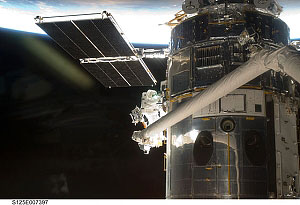 The Hubble Space Telescope being serviced by Space Shuttle
The Hubble Space Telescope being serviced by Space Shuttle
Atlantis astronauts in May 2009. Credit: NASAFour hundred years ago, Galileo built his telescope and became the first on record to point the new device (invented the previous year) at objects in the sky. Today (in fact, even as I write!) what has become a symbol for the current state of evolution of the telescope—the Hubble Space Telescope--is being repaired and upgraded by the crew of the Space Shuttle Atlantis…for the last time.
Galileo's telescope had a magnification of only about 27x, allowing him to see that Venus has phases like the Moon, Jupiter has four large moons of its own, Saturn does not appear as a simple disk but has unusual "projections" to either side, and the Milky Way contains far more stars than is apparent to the naked eye. And though these are features that can be seen through the least powerful home telescopes today, Galileo's observations changed the way we look at the universe.
Hubble has done the same thing, but on a modern scale of magnitude. Not a large telescope by the standards of ground-based behemoths like Keck in Hawaii (Hubble's primary mirror is 2.4 meters in diameter), Hubble's "edge" is it's location in space, orbiting the Earth over 300 miles high, outside of our atmosphere. Particularly in its earlier days before ground based telescopes were using adaptive optics techniques to compensate for atmospheric distortion, Hubble's vision on the universe was unparalleled in its clarity.
Here's is a recap of a few of the many big discoveries Hubble has made possible:
Dark Energy: By accurately measuring the distance and velocity of distant supernovae, over a large range of distances, Hubble has refined out knowledge of the rate of expansion of the universe--leading to the discovery that the expansion of the universe is actually accelerating, contrary to what was expected. Scientists suggest the existence of a mysterious "dark energy" throughout the universe that exerts an antigravitational repulsive pressure on the cosmos.
